Migrate HubSpot to Marketing Cloud Account Engagement (Pardot) [Step-by-Step Checklist]


Makenzi Cotton
Migrating from HubSpot to Marketing Cloud Account Engagement (formerly Pardot) can be an arduous task. But with the right tools and well-informed team, you can make this process as seamless as possible.
Whether you have already decided to make the switch from HubSpot to Marketing Cloud Account Engagement (MCAE) or are currently weighing the pros and cons of the move, you’ll first need a baseline understanding of what it takes to do so.
In this article, we lay out the process of migrating from HubSpot to MCAE, walk through best practices and helpful tips, and ensure your campaigns, workflow, assets and database migrate seamlessly over to MCAE.
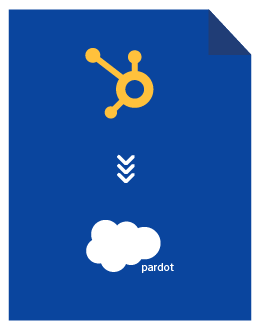
Hubspot to Marketing Cloud Account Engagement Migration Checklist
Download our free migration checklist to plan your transition from Hubspot to Marketing Cloud Account Engagement (formerly Pardot) like an expert.
Before we go any further, let’s take a step back.
Why switch from HubSpot to MCAE?
We often see companies switch to MCAE for its native integration with Salesforce. Because both tools are owned by Salesforce, MCAE is specifically designed to be seamlessly integrated with Salesforce CRM.
Meanwhile, HubSpot requires a custom API to connect with Salesforce CRM.
Account Engagement’s native Salesforce integration allows for powerful reporting. Most custom and default fields and objects from Salesforce can integrate with MCAE, allowing you to create custom dashboards and reports within Salesforce. Advanced tools, like Campaign Influence reporting, grant you access to multi-touch attribution reports that can help close the loop between marketing and sales.
Both HubSpot and MCAE can set up automated workflows, but Account Engagement’s rule, trigger, and action sequence offers more guidance for the complicated process of automating marketing workflows.
Account Engagement’s marketing automation features are available in each of its pricing plans, while HubSpot users have to sign up for the professional or enterprise plan to be able to create automated campaigns. We laid out the most salient similarities and differences between the two systems above so you can manage expectations for your migration.
Similarities | HubSpot | MCAE |
| Email Marketing | Social Media Marketing | Automation Available in All Plan Types |
| Excellent Customer Support Reviews | SMS Marketing | Custom Automation Campaigns |
| Automation | Content Generation Tools | Event Based Reports Available in All Plans |
| Same list of integrations | Create Invoices | Extensive Rules/Triggers/Actions Automation Capabilities |
| Form/Landing Page/Email building tools and templates | Automation Only Available in Professional/Enterprise Plans | Customizable Reporting Dashboards |
| Lead Scoring | Must have Enterprise Plans for Revenue and Event-based Reporting | Very Organized and Structured |
| Custom and Default Fields | Slightly Sluggish Loading Time | Prospect Activity Reports |
| Easy-to-use Interface | API Needed for Salesforce Integration | Quick Performance Speed |
| CRM Integration | Able to integrate with SDFC | Native Integration to SFDC |
Key differences between HubSpot and MCAE
Before you get too deep into the migration, it’s imperative that you have a baseline understanding of how these systems differ. This will allow you and your team to make informed decisions when the time for migration comes.
HubSpot and MCAE contrast in a few key areas. Most of the assets you have built in HubSpot can be rebuilt in MCAE. There will be some differences in how things function, how they are set up, and some automation terminology.
MCAE may use different automation vocabulary words, but many have the same definitions as the HubSpot terms you are used to.
For example, your “contacts” in HubSpot will be considered “mailable prospects” in MCAE. MCAE defines prospects as contacts in your database that have an email address and an assigned user.
Below is a table that shows the MCAE equivalent to some key HubSpot terms. We have included this table in our downloadable checklist as a quick reference for your team:
Email Marketing Definition | HubSpot | MCAE |
| Unknown Website Visitors | Anonymous Visitors | Visitors |
| Mailable Records | Contacts | Prospects |
| A List of Records | Static List | List |
| A List of Records Meeting a Specific Criteria | Smart List | Dynamic List |
| Trigger for Automated Tasks | Workflow Starting Conditions | Automation Rules |
| A Sequence of Emails | Workflow | Drip Program |
| The Activity History of Each Record in the Database | Interactions | Activities |
| The Rating of Each Record Based on Their Fit and Engagement | HubSpot Score | Account Engagement Grade and Account Engagement Score |
| The Marketing Automation Information Presented in Salesforce | HubSpot Intelligence | Account Engagement Activities |
| The Place Where You Store Files | File Manager | Content Files |
Considerations when migrating
How long will migrating from HubSpot to MCAE take?
Transferring all your marketing assets and data from HubSpot to MCAE can be done in as little as 4 weeks; however, we strongly recommend allocating about 6-8 weeks to ensure the shift over to MCAE goes smoothly.
Our past client, Boston Architectural College, was sunsetting their HubSpot and needed to complete their migration to MCAE by the time their fall semester started. To expedite the process, BAC enrolled in EBQ’s implementation and training program to migrate from HubSpot to MCAE.
To learn how EBQ can help you migrate to MCAE more efficiently, read the full BAC case study.
Will I need to have an overlap period with access to both systems?
The short answer is yes. While it is not required to have access to both systems when executing your migration, having an overlap period will make things easier for you and ensure a seamless transition.
Below, we will compare and contrast both migration methods:
With a grace period (recommended):
We recommend having a 6-8 week overlap period where you are subscribed to both HubSpot and MCAE at the same time.
This method allows you to test your new MCAE campaigns to make sure they are accomplishing their goals like they were in the legacy system. If there are any issues, you can revisit HubSpot to see if everything was copied over correctly.
Best of all, it takes an extra step out of the process. No need to export, organize, and house your data somewhere in the interim. Everything should already be organized in HubSpot and ready to be migrated over. The extra cost is worth the efficiency and peace of mind.
Without a grace period:
If you do not have access to both HubSpot and MCAE at the same time, or only have access to both for a short period of time, you will need to make sure you export ALL important assets into shareable text files and organize them accordingly.
Without an overlap period between systems, there is less margin for error. If something gets lost, exported wrong, or forgotten, you may have difficulty getting that data back.
So, if you must use this strategy, make sure all your contacts, forms, landing page templates, email templates, and any other important assets you keep in HubSpot are exported into text files or spreadsheets so they can be easily recreated or imported into MCAE.
What data maps over?
The data that maps over from HubSpot to MCAE includes the following:
- Contact database
- Default and custom fields
- Content files (such as whitepapers, PDFs, and images)
With MCAE, you can import CSV files and sync with your Salesforce account (if you have one) to import HubSpot contacts and Salesforce leads into MCAE as prospects.
Also, content files can be saved from HubSpot and uploaded into MCAE.
What needs to be recreated?
Assets such as emails, email templates, landing pages, forms, and automation campaigns need to be recreated in MCAE. This is why having access to both systems at the same time is important.
If you want to make sure all assets are recreated accurately, having your legacy system to double-check your work makes the process much more efficient.
Can customized assets be imported?
Yes. Although most assets such as email templates, landing pages, and forms can be easily recreated using Account Engagement’s default templates — heavily customized assets can be imported into MCAE via HTML.
You may need the skills of a code-savvy marketer or developer in order to copy over the HTML accurately.
Steps for a successful migration from
HubSpot to MCAE:
Now that we have our preliminary questions answered and baseline knowledge of what the migration will entail, let’s dive into the migration itself.
We recommend the following order:
1. Database
2. Email Content
3. Automation Campaigns
4. Landing Pages
5. Forms
6. Lists
7. Files
8. Scoring Criteria
9. Custom and default fields
10. Integration with CRM
Migrating your database
Contacts in your database and the default fields associated with them can be exported from HubSpot and CSV imported into MCAE using the import wizard. However, the custom fields you use in HubSpot must be created in MCAE before you import your contacts – if you want them to map over.
If there are any fields that are no longer relevant, delete them from your spreadsheet to clean your data. Simply delete the column associated with that field before importing it into MCAE.
You can import your contacts in batches based on the lists and segmentation you use in HubSpot, or you can import them all at once and worry about segmenting your prospect database at a later date.
To import contacts and fields:
- Go to the “contacts” section of your HubSpot account.
- Click “export” in the “options” drop-down menu. This will export all your contacts with all the fields associated with them.
- Any custom fields on your spreadsheet that don’t exist in MCAE must be created in MCAE before the import in order for the contacts spreadsheet to map correctly.
- Once you recreate the custom fields in MCAE, you can upload the CSV file.
- Double-check to make sure the fields are mapped correctly.
- Add any campaigns, tags, or actions.
- Hit “save.”
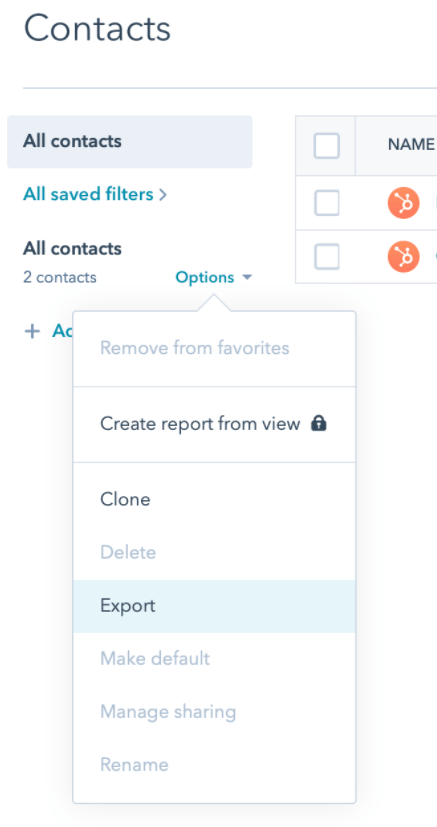
Migrating your email content
Email content and templates cannot be exported from HubSpot to MCAE. In order to migrate your email content, you must recreate them by copying the email text and pasting it into Account Engagement’s email template builder.
You can do this by copying it directly from HubSpot, sending yourself a test email and copying it from there, or saving the copy in a text file.
Account Engagement’s default templates should be able to recreate most of your HubSpot’s email templates. You can recreate the templates by copying the content from your old emails and pasting it into Account Engagement’s content editor.
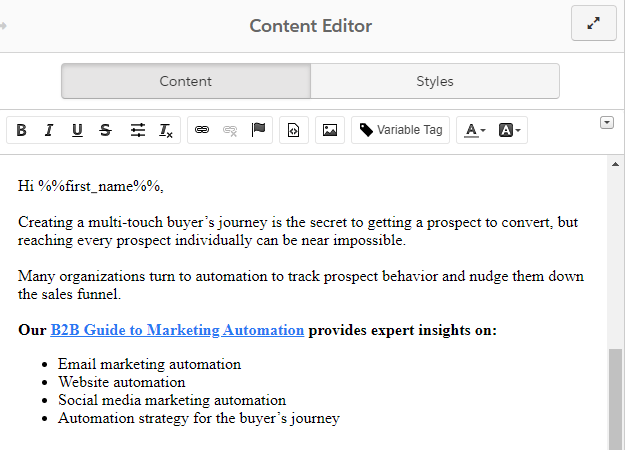
For highly customized email templates, be sure to copy their HTML code from HubSpot and have a code-savvy marketer or developer recreate them in MCAE.
Recreating the emails from your HubSpot drip campaigns in Account Engagement’s email tool, Engagement Studio, will allow you to use the same logic in your campaigns. However, MCAE is an email-centric tool, so Engagement Studio has many more automation capabilities than HubSpot’s workflow tool.
To learn more about what you can accomplish with MCAE Engagement Studio, read our B2B Marketer’s Guide to Pardot.
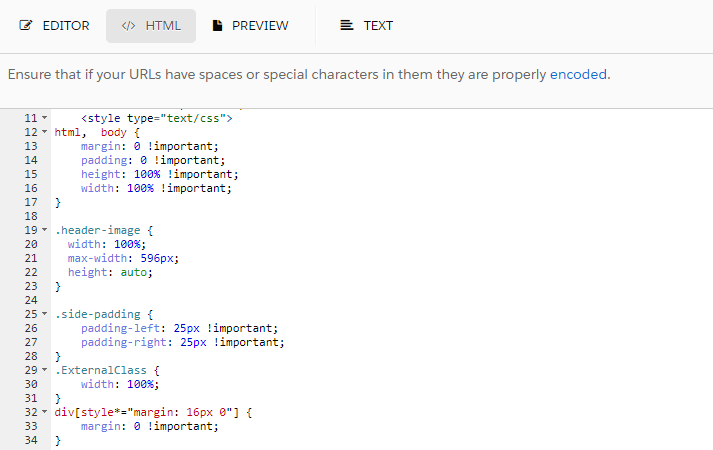
Migrating automation campaigns
If you have the professional or enterprise plan from HubSpot, you may have some workflows and workflow starting conditions that you want to transition over to MCAE.
In MCAE, these workflows and workflow starting conditions are called “automation rules,” “triggers,” and “drip programs.”
Make a note of all the logic from your workflows and starting conditions so that you can easily recreate them in MCAE.
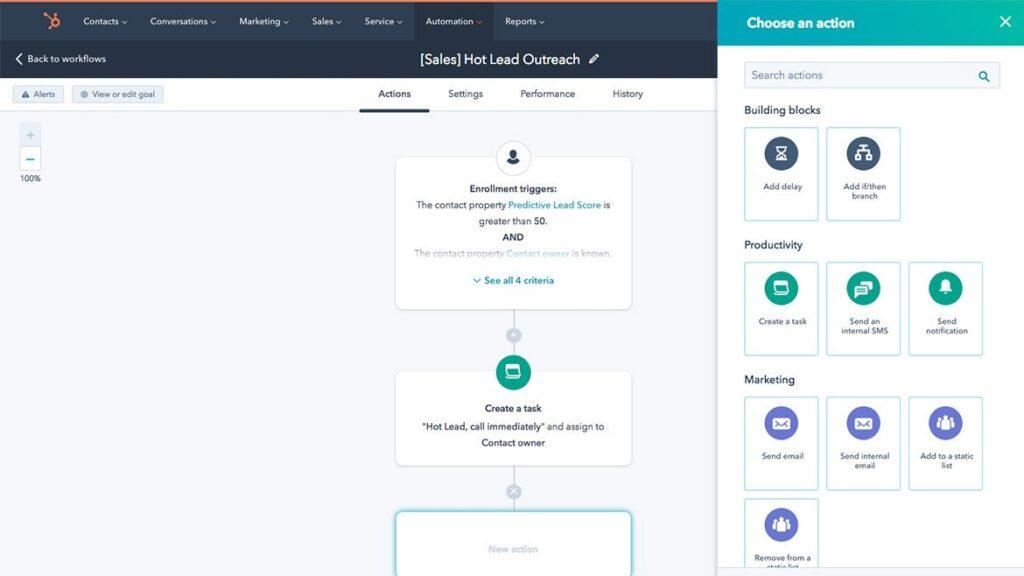
You have three choices when creating your automation workflow in Account Engagement’s Engagement Studio:
- Actions
- Triggers
- Rules
Actions tell the engagement program to do something, such as send an email. This is where you need to note which emails are sent in which campaign.
Triggers tell the engagement program to look for something, such as “did they open the email?” or “did they click the link?” If the prospect executes the chosen action, then it will trigger another action.
Rules tell Engagement Studio to check the prospect database to see if they match certain criteria such as:
- Do they have an MCAE score (lead score) of 50 or higher?
- Are they assigned to user: John?
- Do they belong to a certain list?
- Do they have ____ in their custom field?
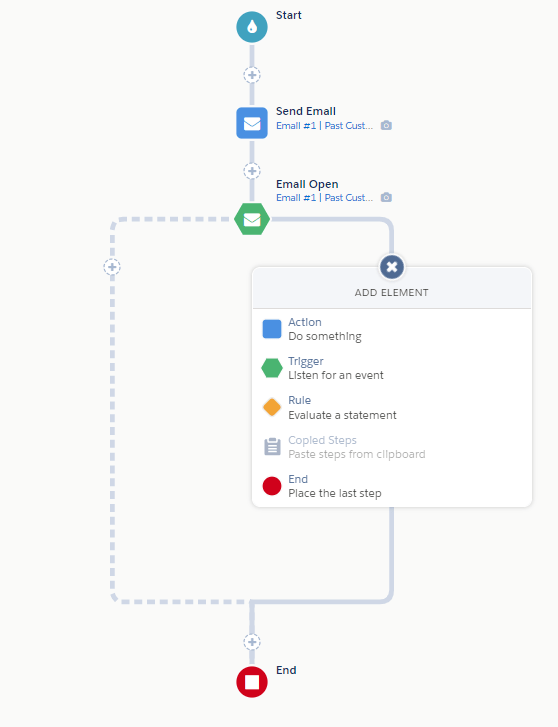
Make sure to poke around Account Engagement’s triggers and actions to see what you can add to your old drip campaigns. You may find something in Account Engagement’s Engagement Studio that was not available in HubSpot’s workflow builder that will improve your old drip programs.
Recreating automation rules should be done in a similar way by making a note of all the triggers, actions, and workflow logic in your HubSpot automations so you can recreate them in MCAE. No two systems are alike across the board. As we mentioned before, MCAE has more automation capabilities, so don’t expect a 1:1 campaign transition.
Testing your automation campaigns in your new system to see if they work is an important reason we recommend having an overlap period between subscriptions. Testing your campaigns before sunsetting your HubSpot plan will make your life easier. If this isn’t an option, make sure you take detailed notes.
Migrating your landing pages
To migrate your landing pages from HubSpot, a full rebuild in MCAE is possible — and very doable. You should be able to get simple landing pages to look close to their current appearance by using Account Engagement’s default templates to recreate them.
Default templates are a great way to get started and can be customized to include your company’s branding and images, and they’ll still look great on mobile devices.
The alternative method should be used for more customized landing page templates. This method involves saving the HTML file for each template and having a developer or code-savvy marketer install the code in Account Engagement’s landing page builder.
Migrating your forms
If you are using HubSpot forms externally on your website, you will want to recreate them in MCAE before you sunset your legacy system in order to avoid losing leads. Take note of all the fields used on your HubSpot forms and recreate them in Account Engagement’s easy-to-use form builder.
Next, you will want to recreate the automated activities that happen after the form is submitted. In MCAE, we call those “completion actions.”
Migrating lists
If you performed a bulk import of all your contacts from HubSpot instead of importing them in batches by segmentation, then you should make a note of all the types of lists and criteria so you can recreate them in MCAE.
Migrating files
If you have any gated content or images stored within HubSpot you want to be transitioned over to MCAE, simply save the content to a folder and upload it into MCAE by navigating to Marketing → Content → Files.
Here, you can upload your files into MCAE so you can link to them in your emails and create gated content.
Changing the scoring criteria
HubSpot and Account Engagement’s scoring system has some differences that will prevent your scoring criteria from transitioning 1:1. If you are using lead scoring, it is important to document the relevant criteria and point assignments so you can recreate them in MCAE.
MCAE has a default prospect scoring system that comes with preset point allocation for specific actions, such as clicking on an email, page views, filling out a landing page form, etc. Luckily, it is customizable so you can change the number of points allocated for each action.
We recommend having a conversation with your sales team to make sure your sales and marketing teams are aligned on what should be included for each score. Later in your timeline, you can revisit the conversation to make sure the scores still align with your team’s efforts after you’ve completed the migration.
To learn more about lead scoring in MCAE, we suggest reading our B2B Guide to Pardot Lead Scoring.
Integration with Salesforce CRM
As we laid out earlier, one of the main reasons marketers choose MCAE over HubSpot is the seamless integration with Salesforce. In MCAE, any changes to prospect records are pushed to Salesforce, and information from Salesforce records is pulled into the corresponding MCAE prospect records. Syncing occurs every 2-4 minutes.
As you may know, Salesforce does not allow two connectors at the same time. If you opted into having a grace period where your MCAE and HubSpot subscriptions overlap, make sure to disconnect the integration between your Salesforce and HubSpot account before trying to integrate your new MCAE account with Salesforce.
Conclusion
If you follow the steps in our downloadable checklist outlined above, you should have no problem migrating all your data, assets, and campaigns over to MCAE.
If you run into any issues, feel free to reach out for further training and support! EBQ is here to help.

Hubspot to Marketing Cloud Account Engagement Migration Checklist
Download our free migration checklist to plan your transition from Hubspot to Marketing Cloud Account Engagement (formerly Pardot) like an expert.
